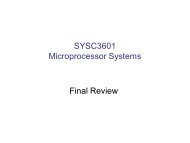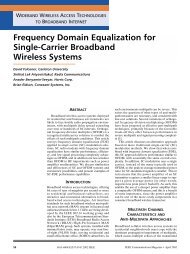Image Reconstruction for 3D Lung Imaging - Department of Systems ...
Image Reconstruction for 3D Lung Imaging - Department of Systems ...
Image Reconstruction for 3D Lung Imaging - Department of Systems ...
You also want an ePaper? Increase the reach of your titles
YUMPU automatically turns print PDFs into web optimized ePapers that Google loves.
a regularization penalty term a much broader class <strong>of</strong> functions are there<strong>for</strong>e allowed to be<br />
the solution <strong>of</strong> the inverse problem, including functions with discontinuities. Another way<br />
to understand the differences with other techniques is to consider the discretized version <strong>of</strong><br />
equation 7.6. Suppose that the conductivity is described by piecewise constant elements,<br />
the TV <strong>of</strong> the 2D image can be expressed as the sum <strong>of</strong> the TV <strong>of</strong> each <strong>of</strong> the k edges, with<br />
each edge weighted by its length:<br />
TV (σ) = � � �<br />
lk<br />
�σm(k) − σ �<br />
n(k)<br />
(7.8)<br />
k<br />
where lk is the length <strong>of</strong> the k th edge in the mesh, m(k) and n(k) are the indices <strong>of</strong> the<br />
two elements on opposite sides <strong>of</strong> the k th edge, and the index k ranges over all the edges.<br />
Equation 7.8 can be expressed in terms <strong>of</strong> matrices as:<br />
TV (σ) = �<br />
|Lkσ| (7.9)<br />
k<br />
where L is a sparse matrix, with one row per each edge in the mesh. Every row Lk has<br />
two non zero elements in the columns m(k) and n (k) : Lk = [0,...,0,lk,0,...,0, −lk,0...0].<br />
TV regularization is there<strong>for</strong>e <strong>of</strong> the ℓ 1 kind: it is a sum <strong>of</strong> absolute values, in this case a<br />
sum <strong>of</strong> vector lengths. The absolute value guarantees the positivity <strong>of</strong> the penalty function<br />
but un<strong>for</strong>tunately results in non–differentiability in the points where σ m(k) = σ n(k). The<br />
numerical problem thus needs to be addressed properly. However, the important gain is<br />
that the ℓ 1 regularization does not penalize discontinuities.<br />
7.2.3.1 Solving TV - Early Approaches.<br />
Two different approaches were proposed <strong>for</strong> application <strong>of</strong> TV to EIT, the first by Dobson<br />
and Santosa [44] and the second by Somersalo et al [109] and Kolehmainen [85]. Dobson<br />
and Santosa replace the absolute value function in the neighbourhood <strong>of</strong> zero by a polynomial<br />
to obtain continuously differentiable function upon which steepest descent is then<br />
used to per<strong>for</strong>m the minimization. Their approach is suitable <strong>for</strong> the linearized problem<br />
but suffers from poor numerical efficiency. Somersalo and Kolehmainen successfully applied<br />
Markov Chain Monte Carlo (MCMC) methods to solve the TV regularized inverse problem.<br />
The advantage in applying MCMC methods over deterministic methods is that they do not<br />
suffer from the numerical problems involved with non-differentiability <strong>of</strong> the TV functional;<br />
they do not require ad hoc techniques. Probabilistic methods, such as MCMC, <strong>of</strong>fer central<br />
estimates and error bars by sampling the posterior probability density <strong>of</strong> the sought<br />
parameters (there<strong>for</strong>e differentiability is not required). The sampling process involves a<br />
substantial computational ef<strong>for</strong>t, <strong>of</strong>ten the inverse problem is linearized in order to speed<br />
up the sampling. What is required is an efficient method <strong>for</strong> deterministic Tikhonov style<br />
regularization, to calculate a non-linear TV regularized inversion in a short time.<br />
Examination <strong>of</strong> the literature shows that a variety <strong>of</strong> deterministic numerical methods<br />
have been used <strong>for</strong> the regularization <strong>of</strong> image de-noising and restoration problems with the<br />
TV functional (a good review is <strong>of</strong>fered by Vogel in [117]). The numerical efficiency and<br />
stability are the main issues to be addressed. Use <strong>of</strong> ad hoc techniques is common, given the<br />
poor per<strong>for</strong>mance <strong>of</strong> traditional algorithms. Most <strong>of</strong> the deterministic methods draw from<br />
ongoing research in optimization, as TV minimization belongs to the important classes <strong>of</strong><br />
problems known as “Minimization <strong>of</strong> sum <strong>of</strong> norms” [11][13][39] and “Linear ℓ 1 problems”<br />
[19][125].<br />
98





